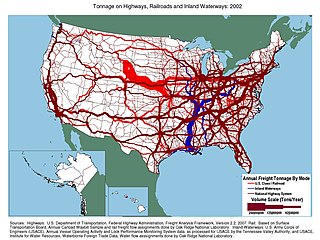 W
WTransportation in the United States is facilitated by road, air, rail, and waterways. The vast majority of passenger travel occurs by automobile for shorter distances, and airplane for longer distances. In descending order, most cargoes travel by railroad, truck, pipeline, or boat; air shipping is typically used only for perishables and premium express shipments. Transportation is the largest source of greenhouse gas emissions by the United States.
 W
W5-1-1 is a transportation and traffic information telephone hotline in some regions of the United States and Canada. Travelers can dial 511, a three-digit telephone number, on landlines and most mobile phones. The number has also extended to be the default name of many state and provincial transportation department road conditions Web sites, such as Wisconsin's site. It is an example of an N11 code, part of the North American Numbering Plan.
 W
WThe Adopt-a-Highway program, and the very similar Sponsor-a-Highway, are promotional campaigns undertaken by U.S. states, provinces and territories of Canada, and some national governments outside North America to encourage volunteers to keep a section of a highway free from litter. In exchange for regular litter removal, an organization is allowed to have its name posted on a sign in the section of the highways they maintain.
 W
WAlcohol-related traffic crashes are defined by the United States National Highway Traffic Safety Administration (NHTSA) as alcohol-related if either a driver or a non-motorist had a measurable or estimated BAC of 0.01 g/dl or above.
 W
WThe Back of the Dragon is a section of Virginia State Highway 16 noted for numerous turns and mountain scenery. It attracts car and motorcyclists enthusiasts from several countries.
 W
WBiodiesel is commercially available in most oilseed-producing states in the United States. As of 2005, it is more expensive than petroleum-diesel, though it is still commonly produced in relatively small quantities.
 W
WThe Canal Age is a term of art used by historians of Science, Technology, and Industry. Various parts of the world have had various canal ages; the main ones belong to civilizations, dynastic Empires of India, China, Southeast Asia, and mercantile Europe. Cultures make canals as they make other engineering works, and canals make cultures. They make industry, and until the era when steam locomotives attained high speeds and power, the canal was by far the fastest way to travel long distances quickly. Commercial canals generally had boatmen shifts that kept the barges moving behind mule teams 24 hours a day. Like many North American canals of the 1820s-1840s, the canal operating companies partnered with or founded short feeder railroads to connect to their sources or markets. Two good examples of this were funded by private enterprise:The Lehigh Coal & Navigation Company used vertically integrated mining raw materials, transporting them, manufacturing with them, and merchandising by building coal mines, the instrumental Lehigh Canal, and feeding their own iron goods manufacturing industries and assuaging the American Republic's first energy crisis by increasing coal production from 1820 onwards using the nation's second constructed railway, the Summit Hill and Mauch Chunk Railroad. The second coal road and canal system was inspired by LC&N's success. The Delaware and Hudson Canal and Delaware and Hudson Gravity Railroad. The LC&N operation was aimed at supplying the country's premier city, Philadelphia with much needed fuel. The D&H companies were founded purposefully to supply the explosively growing city of New York's energy needs.
 W
WA control city is a city, locality, or other location posted on a series of traffic signs along a particular stretch of road indicating destinations on that route. Together with route numbers and cardinal directions, these focal points aid the motorist navigating along a highway system. Such cities appear on signs at junctions to indicate where the intersecting road goes and where the road ahead goes. They are also typically used on distance signs.
 W
WIn the United States, driver's licenses are issued by each individual state, territory, and the District of Columbia rather than by the federal government due to federalism. Drivers are normally required to obtain a license from their state of residence and all states recognize each other's licenses for non-resident age requirements. There are also licenses for motorcycle use. Generally, a minimum age of 16 is required to obtain a drivers/M1 license. A state may also suspend an individual's driving privilege within its borders for traffic violations. Many states share a common system of license classes, with some exceptions, e.g. commercial license classes are standardized by federal regulation at 49 CFR 383. Many driving permits and ID cards display small digits next to each data field. This is required by the American Association of Motor Vehicle Administrators’ design standard and has been adopted by many US states. According to the United States Department of Transportation, as of 2018, there are approximately 227 million licensed drivers in the United States.
 W
WThe United States federal excise tax on gasoline is 18.4 cents per gallon and 24.4 cents per gallon for diesel fuel. The federal tax was last raised October 1, 1993 and is not indexed to inflation, which increased by a total of 77 percent from 1993 until 2020. On average, as of April 2019, state and local taxes and fees add 34.24 cents to gasoline and 35.89 cents to diesel, for a total US volume-weighted average fuel tax of 52.64 cents per gallon for gas and 60.29 cents per gallon for diesel.
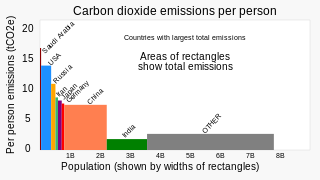 W
WThe United States produced 6.6 billion metric tons of carbon dioxide equivalent greenhouse gas (GHG) emissions in 2019, the second largest in the world after greenhouse gas emissions by China and among the countries with the highest greenhouse gas emissions per person. In 2019 China is estimated to have emitted 27% of world GhG, followed by the United States with 11%, then India with 6.6%. In total the United States has emitted 400 billion metric tons, more than any other country. This is over 15 tonnes per person and, amongst the top ten emitters, is the second highest country by greenhouse gas emissions per person after Canada. Because coal-fired power stations are gradually shutting down, in the 2010s emissions from electricity generation fell to second place behind transportation which is now the largest single source. In 2019, 29% of the GHG emissions of the United States were from transportation, 25% from electricity, 23% from industry, 13% from commercial and residential buildings and 10% from agriculture.
 W
WThe following is a list of United States cities of 100,000+ inhabitants with the 50 highest rates of public transit commuting to work, according to data from the 2015 American Community Survey. The survey measured the percentage of commuters who take public transit, as opposed to walking, driving or riding in an automobile, bicycle, boat, or some other means.
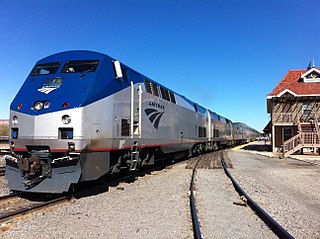 W
WPublic transportation in the United States refers to publicly financed mass transit services across the nation. This includes various forms of bus, rail, ferry, and sometimes, airline services. Most established public transit systems are located in central, urban areas where there is enough density and public demand to require public transportation. In more auto-centric suburban localities, public transit is normally, but not always, less frequent and less common. Most public transit services in the United States are either national, regional/commuter, or local, depending on the type of service. Furthermore, sometimes "public transportation" in the United States is an umbrella term used synonymous with "alternative transportation", meaning any form of mobility that excludes driving alone by automobile. This can sometimes include carpooling, vanpooling, on-demand mobility, infrastructure that is fixated toward bicycles, and paratransit service.
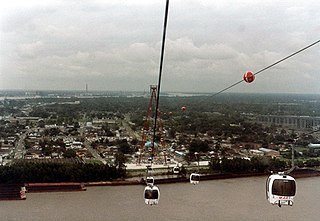 W
WThe Mississippi Aerial River Transit, or simply MART, was a gondola lift transport system spanning the Mississippi River in New Orleans, Louisiana, United States. It was constructed for the 1984 Louisiana World Exposition. After the fair, this served as the second urban aerial lift and the first gondola lift commuter system in the United States, in operation for just a year before closing.
 W
WThe National Association of City Transportation Officials (NACTO) is a coalition of the Departments of Transportation in North American cities.
 W
WThe National Cooperative Highway Research Program (NCHRP) conducts research in problem areas that affect highway planning, design, construction, operation, and maintenance in the United States. Spearheaded by the Transportation Research Board (TRB), part of the National Academies of Sciences Engineering and Medicine, it is jointly supported by federal agencies, state departments of transportation, and other nonprofit organizations.
 W
WThe National Explosives Detection Canine Team Program is a program administered by the Transportation Security Administration which uses law enforcement and TSA-run explosive detection dog teams to detect explosives in transportation environments.
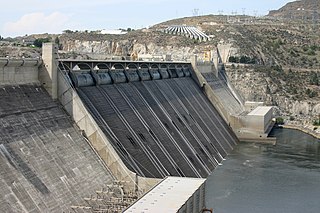 W
WThe creation of a National Infrastructure Reinvestment Bank was first proposed by United States Senator Christopher J. Dodd and Senator Chuck Hagel in 2007. However, several other iterations of a National Infrastructure Bank have been proposed and considered and it is likely that implementing legislation for the Bank will look quite different from that which was proposed in the original legislation.
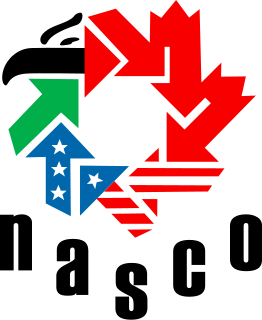 W
WThe North America's Corridor Coalition (NASCO) is a non-profit organization that seeks to develop an international multi-modal transportation system along the International Mid-Continent Trade Corridor, which it claims will improve trade competitiveness and quality of life in North America.
 W
WRickshaws are used in numerous cities in the United States, primarily for their novelty value as an entertaining form of transportation for tourists and locals. However, they also have environmental benefits and may be quicker than other forms of transport if traffic congestion is high. Various laws regulate their use in different areas.
 W
WSeat belt use rates in the United States has been rising steadily since 1983, from 14% to 90% in 2016. Seat belt use in the country in 2016 ranged from a minimum of 70.2% in New Hampshire to a maximum of 96.9% in Georgia. 19 states had use rates above 90%.
 W
WThe United States secretary of transportation is the head of the United States Department of Transportation. The secretary serves as the principal advisor to the president of the United States on all matters relating to transportation. The secretary is a statutory member of the Cabinet of the United States, and is fourteenth in the presidential line of succession.
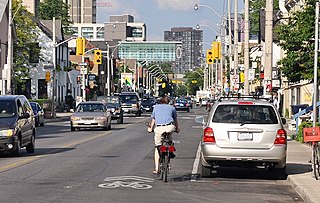 W
WA shared lane marking, shared-lane marking or sharrow is a street marking installed at locations in New Zealand, Australia, Canada, Spain, or the United States. This marking is placed in the travel lane to indicate where people should preferably cycle.
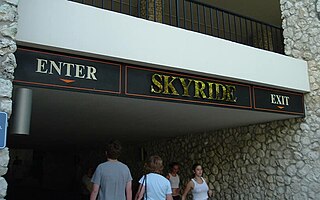 W
WSkyride is a transportation attraction at Busch Gardens Tampa Bay in Tampa, Florida. It carries passengers from the Edge of Africa section of the park to the Stanleyville section or vice versa. During this experience, passengers get a bird's-eye view of several attractions at the park.
 W
WTransportation safety in the United States encompasses safety of transportation in the United States, including automobile crashes, airplane crashes, rail crashes, and other mass transit incidents, although the most fatalities are generated by road incidents yearly killing from 32,479 to nearly 38,680 (+19%) in the last decade. The number of deaths per passenger-mile on commercial airlines in the United States between 2000 and 2010 was about 0.2 deaths per 10 billion passenger-miles. For driving, the rate was 150 per 10 billion vehicle-miles for 2000 : 750 times higher per mile than for flying in a commercial airplane.
 W
WThe Transportation Security Administration (TSA) is an agency of the U.S. Department of Homeland Security that has authority over the security of the traveling public in the United States. It was created as a response to the September 11 attacks under the administration of President George W. Bush, to improve airport security procedures and centralize air travel security under a single federal agency.
 W
WThe Transportation Worker Identification Credential program is a Transportation Security Administration and U.S. Coast Guard initiative in the United States. The TWIC program provides a tamper-resistant biometric credential to maritime workers requiring unescorted access to secure areas of port facilities, outer continental shelf facilities, and vessels regulated under the Maritime Transportation Security Act of 2002, or MTSA, and all U.S. Coast Guard credentialed merchant mariners. As of May 2014, there were 2,999,058 people enrolled in the program. Those seeking unescorted access to secure areas aboard affected vessels, and all Coast Guard credentialed merchant mariners, must obtain a TWIC. The new measures were fully implemented on April 15, 2009. To obtain a TWIC, an individual must provide biographic and biometric information such as fingerprints, sit for a digital photograph and successfully pass a security threat assessment conducted by TSA.